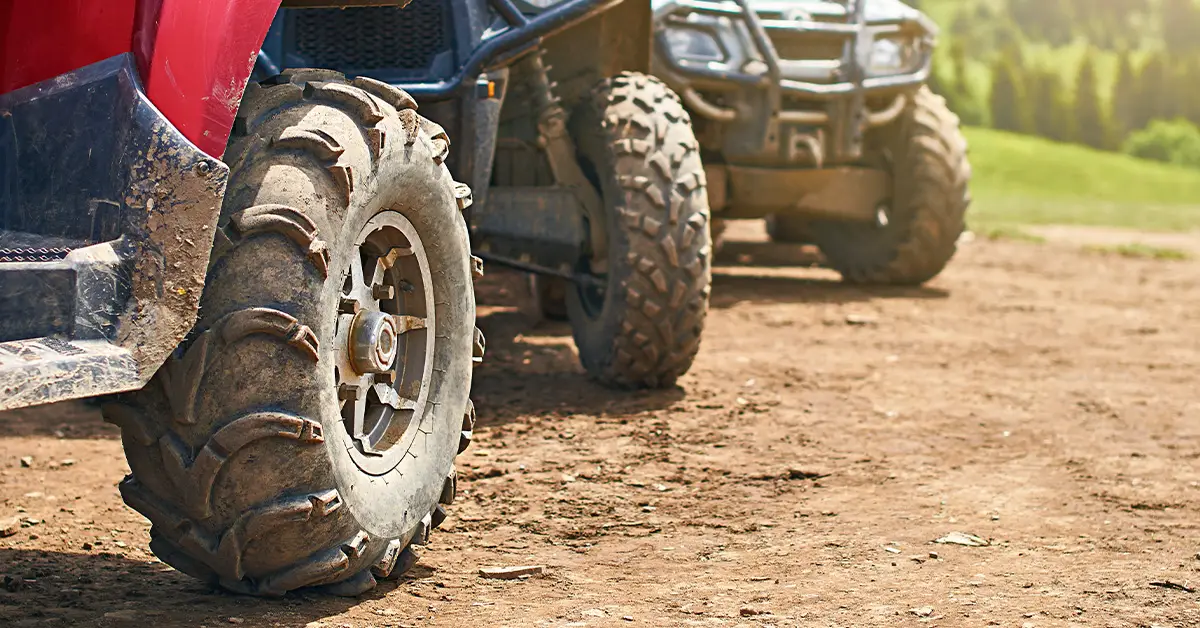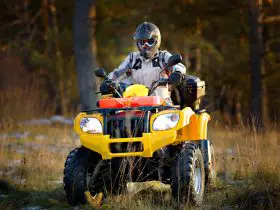Most ATVs you will find on the market today have a power steering system by default. But for some reason, maybe you ended up with an older version of a quad bike without power steering. It could also be that you are inheriting the quad. Or perhaps you settled for a used ATV, but you are considering adding a power steering or steering assist system (SAS).
Even if your quad bike does not come with this technology, the majority of models out there allow SAS as an upgrade. But should you opt for power steering or not on ATV? Yes, installing the system on your four-wheeler is almost always worth the extra cost you will incur.
It does not matter whether you add an electric power steering (EPS) [also known as motor-driven power steering (MDPS)], hydraulic power steering, or electro-hydraulic power steering.
All these systems can help minimize the physical efforts the rider puts in to turn the wheels, especially when moving at low speeds. They also reduce handlebar whip and make it easy to haul heavy loads while improving safety.
Keep reading to learn about the benefits and drawbacks of power steering on ATVs.
Table of Contents
How Does Power Steering Work On ATVs?
The mechanics behind wheel maneuvering vary depending on the type of power steering system installed. However, all the systems follow similar basic principles.
When a SAS is in place, the handlebar or steering force transferred to wheels improves. The forces transmitted from the ATV wheels to the handlebar or steering wheel reduce.
Steering assist systems are automatic. The sensors on SAS help detect torque or the effort exerted on the steering wheel or handlebar. The system picks up these details and decides the level of power steering assistance to supply.
When you apply force, it passes through motor-powered mechanical components. The mechanical assembly amplifies your input force, resulting in a greater output force that helps the ATV riders to maneuver the wheels.
Power Steering On ATV Benefits
Do you really need power steering on your ATV?
As mentioned earlier, adding SAS influences how your quad functions. It is imperative to point out that there’s the good and the bad side to upgrading, depending on the SAS you opt to install on your four-wheeler.
Therefore, you have to consider that as well. In our previous power steering or not on UTVs post, you can find out the pros and cons of each type of power steering system.
Some ATV riders can do fine without SAS, especially the experienced ones with good muscle strength. Many have been using their bikes for years without EPS or other systems.
However, most drivers agree that having the power steering technology undoubtedly improves their experiences, making riding more enjoyable. As for riders new to operating quad bikes, you will probably want to add the power steering system.
With that in mind, here are the general advantages of power steering on ATVs:
1. Reduces the undesired kickbacks
No ATV rider enjoys the kickbacks through the steering wheel or handlebars when maneuvering rough or rocky terrain. Fortunately, your EPS can help dampen the handling from sudden bumps when you hit the rocks, stumps, and more. Of course, power steering will not eliminate these kickbacks.
However, they will not be as strong as those experienced if you drive without a power steering system. It is an excellent feature if you want to improve safety while riding your ATV. The risk of your quad overturning or you falling off of and suffering injuries reduces significantly.
2. Encourages long rides
Let us face it; operating your quad bike on rough and rocky tracks can leave you feeling depleted of energy, especially after long riding sessions.
Fatigue will eventually kick in when you spend several hours on technical trails (maybe while carrying loads) — even if you are a physically fit ATV rider.
With a steering assist system, you will have more control over your quad bike while applying less effort. You can complete long rides without exhausting your arms.
3. Great for riders with physical weakness
Operating a quad bike without SAS demands a level of physical fitness. If that is the limiting factor, you may not have to worry about it when you add a power steering system to your ATV.
A power steering system may be ideal for:
- Elderly ATV riders
- ATV riders with should problems
- ATV riders who have previously suffered shoulder injuries
4. Easier to carry heavy cargo
Most quad bikes allow you to haul loads that can even exceed the weight of the ATV itself. Transporting heavy loads, such as bales of hays, around the farm can easily prove an intimidating task.
The increased pressure you feel on the handlebars will exhaust your arm, prompting you to take several breaks. You will spend more time or days completing the hauling or transportation work.
Adding SAS to your ATV will reduce the pressure contributing to fatigue in your arms.
5. Increases the resale value
ATVs are so expensive. That is probably one of the reasons some buyers opt for used quad models. If you do not see yourself keeping the four-wheeler forever, you can be sure that your quad with SAS can fetch a high resale price.
Most second-hand buyers have increasingly become more inclined to quad bikes with a power steering system. With this feature, you might attract more potential buyers and have stronger bargaining power.
Your machine will, without a doubt, not get stuck in the market for a long time before you finally sell it.
What are the disadvantages of power steering on ATVs?
For a more informed decision on whether you should consider power steering or not on ATV, you have to be aware of the following drawbacks.
Upfront costs
The power steering functionality comes at a cost. How much does power steering on ATV cost?
On average, quad bike riders pay around $700 to add this feature. Generally, the price range is between $500 and $1,200. Of course, this does not take into account the cost of labor.
Experienced and professional mechanics usually spend 2 to 5 hours installing the power steering system. Given ATV and UTV dealers charge about $100 or more per hour, the costs can add up quickly.
However, in all honesty, the benefits you get outweigh the upfront costs you will incur to get the feature. For instance, 135,000 ATV riders get injured every year.
While we are not implying that riding a quad bike with SAS exempts you from accidents, having the feature onboard increases your safety. It can help you prevent the high medical fees involved in treating ATV injuries.
Increased weight on your four-wheeler
Another disadvantage that some ATV riders may be concerned about is the added weight load on the machine. More weight could mean an increased load on the bike engine.
Consequently, your four-wheeler will burn more fuel over time. The additional weight is not a big deal, though. You might not even notice the difference.
Manufacturers understand this issue, so they try to limit the load on your quad as much as possible. We recommend comparing the weight specifications of different systems to see which one suits your preferences.
Maintenance and repairs
Steering assist systems consist of technical equipment, including motors, controller units, and gear. Like any other system with electronic or mechanical components, your power steering is bound to develop issues at some point.
Breakdowns or malfunctions are not annoyingly frequent. With a high-quality system and professional installation, you can minimize and prevent these issues from arising too soon after the initial purchase.
Even so, repairs are inevitable. You have to factor them into your ATV maintenance budget. However, the costs associated with ATV/UTV repair will not hurt your bank account for sure.
What happens if you lose power steering? Can you still ride your ATV?
Some four-wheeler riders often wonder if a steering assist system fails to work for whatever reason, their machine would be inoperable.
The truth is that — the way the motor gets connected with the steering column allows you to ride your quad bike even if the SAS suddenly goes out.
But you will need to exert more effort to turn the wheel and steer the vehicle. To be precise, there will be no difference between you and the quad bike rider without a steering assist system.
Is Power Steering On ATV Worth It? The Final Thoughts
In our experience, power steering is a useful function worth adding to your quad bike. It is not a luxury feature, as many drivers tend to assume.
Even the most experienced ATV riders have it. Many ATV riders we have interacted with swear by this feature, citing it helps them reduce fatigue and injuries when maneuvering the rocky trails.
The inexperienced teens, the elderly, and riders with physical weakness can also benefit from installing or buying an ATV with power steering technology.
If your budget allows installing a power steering system, go for it. You will not regret upgrading.










